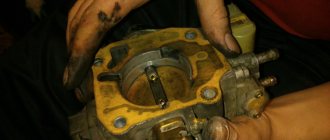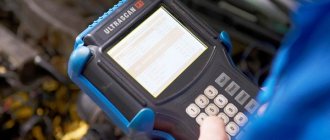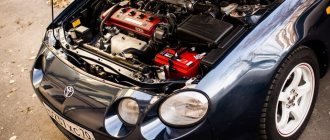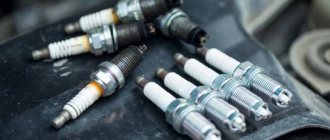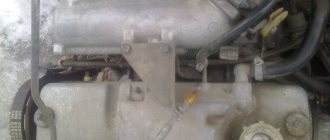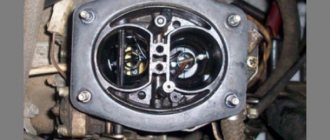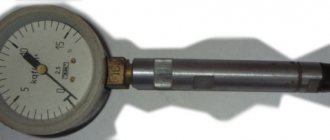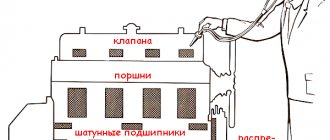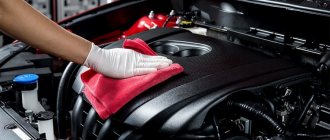What does failure mean?
Failure is nothing more than an interruption in the operation of the power unit. The latter simply reacts untimely to pressing the pedal. Let's say the driver needs to quickly accelerate to perform a maneuver, but the engine does not gain speed.
An interruption is always accompanied by a loss of speed, in some cases up to a complete stop of the machine. It should be understood that dips appear in any case: at low, medium and high speeds, during slow or fast acceleration, etc.
On injection internal combustion engines, the cause of failure is often hidden in fuel supply problems. After pressing the accelerator pedal, the pilot of the car gives the order to increase the dose of fuel, but the electronics understand this in their own way.
The reason for the appearance of failures in the injection system can be a clogged FTO (filter). Because of this, gasoline is supplied to the fuel rail in small quantities, which ultimately leads to malfunctions of the power unit. Therefore, it is important to check it, without also losing sight of the other filter - located inside the submersible pump. This is a mesh that traps large particles of litter.
How to fix
It is better to immediately contact specialists at a car service center. This is what all owners usually say, who are not accustomed to doing their own repairs, do not show any initiative, and expect others to do everything for them. Yes, this is a good aspiration, but we warn you that today quite a lot of dubious auto repair shops are opening in the country, where it is unclear who works without the proper qualifications. Entrusting the work to an amateur is like signing a machine's death warrant.
This is not the only reason why a car owner decides to repair it himself. Sooner or later, every experienced motorist should be able to tune the operation of the “iron horse” so that it is always in shape.
So, the reasons for the failure of an injection engine are hidden in various factors. For example, here you need to switch attention from purely mechanical breakdowns to electronic ones. We are talking about the functions of electronics, its control of the injection system.
To more specifically determine the cause, it is necessary to identify the type of failure. For example, in carburetor engines, the most common type of failure is a momentary lack of thrust, followed by a sudden jerk. This failure is explained by clogging of the carburetor or jets, failure of spark plugs, etc. An injection engine is characterized by twitching or rocking when a series of prolonged failures occurs.
Learn more about types of failures.
| Type of failure | What's happening |
| Short term failures | The engine does not respond to pressure for 2-3 seconds. |
| Long or prolonged dips | The power plant loses speed for 4-10 seconds, which is enough for a complete stop. |
| Jerks | Very short-term dips, lasting 1-2 seconds. |
| Twitching | A series of short-term dips, causing the car to either gain speed or slow down at the same position of the gas pedal. |
| Rocking up | A series of prolonged dips, acts like a twitch, but the time to gain speed and reset it is above 4 seconds. |
Owners of injection cars have noticed another type of failure, when it is when driving at medium and high speeds that an attempt to accelerate leads to the front end of the car pecking. The feeling is that you are sitting behind the wheel of a carburetor car with clogged jets.
In general, it should be understood that a disruption in the operation of the system leads to a change in the proportions of fuel assemblies. An excessively lean or enriched fuel assembly negatively affects the power plant; it is not able to increase speed when needed.
Thus, we can conclude that the first reason for the occurrence of failures on the injector is the pressure drop on the ramp. As you know, a parameter of 3 Bar is considered normal for an injection system. To eliminate failures (if the cause is pressure), you need to measure the pressure and compare the values with the standard ones. If the indicators are very different, then find the reason. It is possible that there is an air leak in the system or the injector is faulty.
Another reason may be the operation of sensors involved in the process of mixture formation. The sensors are responsible for the supply of fuel and air and regulate the crankshaft speed. To check all these details, it is enough to use standard instruments. They will make it possible to first test the pressure in the ramp, and then the condition of the sensors themselves. As for the general inspection of injectors, this is done using special equipment.
If the diagnosis of the reasons causing the failures yields nothing, you should definitely check the ignition system.
Forget about fines from cameras! An absolutely legal new product - Traffic Police Camera Jammer, hides your license plates from the cameras that are installed in all cities. More details at the link.
- Absolutely legal (Article 12.2);
- Hides from photo and video recording;
- Suitable for all cars;
- Works through the cigarette lighter connector;
- Does not cause interference to radios and cell phones.
Source
What are failures?
If, when you sharply press the gas pedal, a failure occurs in the engine, you need to urgently look for the cause of this situation and eliminate it without delay. The problem is serious and even dangerous for the driver, especially when overtaking.
In general, failure of the engine is manifested in the form of a lack of response on its part to the depressed gas pedal. Thus, when trying to accelerate, the engine does not gain the required speed. Engine failures can have different manifestations:
- Brief dips that last only a few seconds. But, believe me, this time is enough to create a dangerous situation on the road.
- Prolonged engine silence can last up to 10 seconds. Often even the car stalls.
- Jerks in which the car jerks. Such failures last 1-2 seconds.
- Numerous jerks that follow each other. In such a situation, the motor changes its operating speed despite the constant position of the accelerator.
- A series of prolonged failures causes serious jerking of the car.
Regardless of how the car behaves, the problem must be fixed immediately. Such a malfunction can cause an accident, especially in icy conditions or when performing a maneuver. Difficulties during acceleration of injection and carburetor engines occur for various reasons. We will talk about this further.
Why are the revs dropping?
There are many reasons that can provoke failure when pressing the gas pedal. This circumstance significantly complicates diagnosis.
- Spark plugs and high voltage wires are the first thing you need to pay attention to when this problem occurs. The problem with spark plugs is carbon deposits that occur during vehicle operation. Carbon deposits cause incorrect operation of the spark plugs, which in turn leads to engine failure. Wires do not often become the cause of such a malfunction, but still their condition is also checked without fail. During the diagnostic process, a fracture or poor contact may be detected.
Carbon deposits on spark plugs
- Injectors worry owners of cars with high mileage. These elements are prone to blockages, which cause interruptions in their operation. The consequence of this state of affairs is a lean fuel mixture.
- The throttle valve can also become clogged and stick. A coating forms on the surface of the valve, which does not allow the throttle to perform its functions normally. This prevents the engine from gaining momentum.
- Incorrectly adjusted ignition is a rare cause, but it does occur. This malfunction can be eliminated in a few minutes by properly adjusting the mechanism. But only an experienced specialist can do this.
- Errors in the ECU that can accumulate during operation of the machine. When a lot of them accumulate, the engine's response to the accelerator may be delayed.
- Blockages in the air filter lead to suffocation of the engine, which experiences “oxygen starvation”.
- Incorrect operation of the fuel pump can be associated with various problems (poor contacts, blockages in the filter, power failure, breakdown of working units).
Diesel
Diagnosis of failures on diesel cars is practically no different from injectors.
But, there is one additional option, specific to diesel engines. At low temperatures, diesel fuel can thicken, which, at best, will cause unstable engine operation. To avoid this, refuel only at proven gas stations; it is also advisable to use specialized additives in cold weather. Conclusion . A car engine is a rather complex technical unit that can sometimes break down. Therefore, the question of what to do if the engine choke when you press the gas is not uncommon. There are quite a few reasons for this behavior. Due to this, verification can take quite a long time.
How to get rid of problems caused by a drop in speed
A failure in the engine during significant acceleration can occur for various reasons - this has already been dealt with. These reasons vary depending on what type of engine is installed in the car: carburetor or injection. Accordingly, methods for troubleshooting also vary. We have to deal with this now.
Checking the carburetor system
Initially, the operation of the fuel system is checked to see how smoothly and correctly it works. Every working unit and detail matters. Air leaks are checked, fuel lines are examined and the fuel pump is diagnosed. All blockages and deposits are removed.
If the diagnostics do not reveal any problems, then the carburetor may cause a failure in the engine when the gas pedal is pressed. This part is responsible for supplying fuel. During normal operation of the carburetor, fuel is supplied without interruption, constantly and evenly.
To identify and eliminate the cause of the problem, you must proceed as follows:
- We exclude air leaks, which may occur due to a loose fastening on the exhaust manifold.
- We study the condition of the mesh-type filter, which is located in the area where the pipe from the fuel pump connects.
- We dismantle the EPH valve and the sealing ring and examine their condition. If the EPHH is working properly, then when you connect one side of the wire to the terminal, and the opposite end to the positive terminal of the battery, a clicking sound will be heard.
- Check the liquid level in the float chamber. To do this, start the engine, leave it to run for a while, remove the top carburetor cover and filter housing. Now let's evaluate the fuel level. In normal condition, it should be in the middle of the inclined wall.
- The dosing system may become clogged and this is a common problem. To eliminate it, you will need to remove the top part of the dispenser and the jets. We look for blockages and remove them using wooden parts. Emulsion tubes, which are often forgotten, also need inspection and maintenance.
- Special products are used to clean the carburetor channels.
Drop in speed on injection models
In the case of injection cars, when failures occur in the engine, the fuel supply system is first checked to see how well this system works. What you need to pay priority attention to:
- Is there a blockage on the fine filter?
- The fuel pump operates stably.
- Clean filter mesh on the intake.
- Is the fuel rail pressure normal? The norm for this indicator starts from 2.8 and reaches 3.2 Bar.
- The sensors that regulate the formation and supply of the fuel mixture are functioning normally.
- How many errors have accumulated in the ECU?
- The throttle valve has collected debris.
- Injectors can cause failures in the operation of an injection engine when you press the gas pedal. We definitely check their functionality.
To carry out a complete diagnosis with your own hands, you need a multimeter and a pressure gauge. Some working components (injectors, throttle valve, ECU) can only be checked by specialists. If the cause has not been identified, then you need to check the ignition system. First of all, pay attention to the spark plugs. Then the wiring, main operating components and the installation itself are checked.
Do not delay in solving the problem. It will not go away on its own, the situation will only get worse. Ultimately, more serious problems with the vehicle may arise that will take longer and be more expensive to fix. Moreover, the risk of accidents increases significantly. But you cannot skimp on safety; not only your life is at risk, but also that of other road users.
Source
Carburetor engines
The first thing that should be checked on such cars is the ignition system. A weak spark is not able to ignite a sharply increased amount of fuel. Therefore, when you press the gas sharply, a drop in speed may be observed, the spark plugs simply flood
. Check all spark plugs. They should produce a bright white-blue spark. If one of them gives a red or orange spark, then check it on the other wire. If nothing has changed, then replace it. For greater reliability, it is recommended to replace spark plugs with a complete set.
If the reason is not the spark plugs, then it makes sense to check the ignition system completely. Pay attention to high voltage wires. They must not be damaged, the insulation must be clean. To check, you will need a multimeter; use it to measure the resistance of the wire. Depending on the manufacturer, the indicator can range from 3.5 to 10 kOhm
, the specific characteristics of the wire are usually indicated on the insulation.
If the resistance value is higher or tends to infinity, then the wire should be changed. There is a “folk” method of verification. To do this, start the engine in the dark and open the hood. You will immediately see the location of the current leak by a bright blue discharge. Cleaning the distributor contacts may also be helpful. So, we checked the ignition, but it didn’t do any good. Let's move on to the carburetor. Most often, the problem is a malfunctioning accelerator pump. In this case, it simply cannot cope with the resulting load, resulting in the engine being left without fuel for a short time. To check, you will need to partially disassemble the carburetor. Before doing this, pump fuel into the float chamber using the lever on the fuel pump. Remove the top of the carburetor. Once you have access to the accelerator, press the lever that activates it several times. You should pay attention to the quality of gasoline atomization. The torch must be uniform and powerful enough. If little fuel is supplied and this happens unevenly, then it is necessary to clean the jets. Be sure to check the fuel filters. There are 2 of them in carburetors:
- The main one is located in front of the fuel pump;
- Fine cleaning. Installed in the carburetor.
If they become clogged, failures at high speeds will also be observed. If necessary, change clogged filters. It would be a good idea to check the operation of the fuel pump. To do this, remove the central wire from the distributor (so that the car does not start), after which the fuel supply hose is disconnected from the carburetor and lowered into any bottle. Turn the starter for a few seconds. If the pump is working properly, fuel will be actively supplied to the bottle. Otherwise, replace the pump.
Main reasons
When dips appear when you press the pedal, you need to check the following elements.
- Set of high-voltage wires and spark plugs. The latter are criticized more often than other details. If the owner regularly refuels with fuel with harmful additives, over time the electrode becomes overgrown with carbon deposits, as a result of which the spark supply deteriorates. If the source of the problem is a high-voltage wire, you will have to replace it. Better - the whole set at once.
- Injectors. Again, the injection engine does not respond well to clogged fuel injectors. A lean fuel mixture results in the engine not responding to pressing the gas pedal. There are two options - washing in an ultrasonic bath, or completely replacing the kit.
- Throttle valve. If there is a large layer of dirt, it jams, which leads to incorrect operation. The resulting deposit prevents the throttle from functioning normally.
Note! If the cause of the breakdown is a broken wire, it is better to buy the entire set - it is possible that other wires will begin to behave the same way.
When pressed hard
These are the main reasons why a car behaves this way when you press the gas pedal hard. Typically, this behavior is observed for one or two seconds, after which the engine, having reached medium speed, continues to operate without problems.
RPM failure
A drop in speed is manifested by the lack of engine response to the pressed gas pedal. When the driver tries to pick up speed, the car does not react at all, or does it too late. This manifests itself as follows:
- A short dip lasting 3-5 seconds. But this is enough to create a dangerous situation on the road.
- Prolonged lack of response. Up to ten seconds, sometimes more. The car has every chance of stalling.
- Jerks with jerking. Duration - about two seconds.
- Numerous consecutive jerks. The engine operates differently when the gas pedal is in one position.
- A series of deep failures. The car is shaking seriously.
Injector
To determine the causes of failure when pressing the gas pedal in the injector, special diagnostic equipment is used. In most cases, improper operation occurs due to a faulty throttle position sensor. First it checks:
- fine filter clogging level;
- stability of the fuel pump;
- cleanliness of the mesh filter on the intake;
- pressure level inside the fuel rail. Range – 2.8-3.2 bar;
- condition of fuel supply and mixture formation sensors;
- number of errors in the ECU memory;
- condition of the injectors.
Assessment of the condition of the throttle valve, control unit and set of injectors is carried out only in the service class=”aligncenter” width=”700″ height=”400″[/img]
Possible reasons
Several parts can be the source of this problem. In carbureted cars, a common culprit is the carburetor itself. It is recommended to configure it.
Also be sure to check the spark plugs. They should not have heavy carbon deposits or visible defects. Also inspect the wiring. On carburetor and diesel vehicles, we recommend additionally checking the following components:
- fuel distribution system. Clogged jets cause jerks and dips when you press the gas sharply;
- injector;
- electronic fuel supply system;
In modern foreign cars, the on-board computer often causes failures. Here you should carry out computer diagnostics in a specialized service.
Diagnostics
Checking the injector is faster because there is an electronic control unit. After reading the error codes, the source of the problem can be clearly identified. Carburetor cars do not have this option. Therefore, such a system is diagnosed in its own way.
First you need to check the coherence and correct operation of the fuel system. You have to probe all the places where air leaks may occur. The fuel pump and fuel line are also checked. There should be no deposits or blockages.
If the test results do not reveal any problems, the failure most likely occurs due to the carburetor. This is the main device responsible for mixture formation and intake into the manifold. When the carburetor is working properly, fuel flows evenly without interruption.
Troubleshooting
The sequence of actions is as follows.
- Eliminate air leaks caused by loose fasteners on the exhaust manifold.
- Check the condition of the fuel filter.
- Remove the idle air control valve with the sealing ring and check their condition. It works correctly when a click appears when connected to the positive terminal (the negative is connected in advance).
- Check the fluid level in the float chamber. The tolerance is the middle of the inclined wall.
- Blow out the fuel and air jets with an air compressor and clean the emulsion tubes.
- Use carburetor cleaner to remove carbon deposits from the carburetor walls.
Thanks to this test, you will find out exactly what causes failure when you press the gas pedal. Luck with searching!
Source
Carburetor systems
Although these engines are no longer produced, modern units have long moved to a new level of working mixture formation. However, old cars are still found in some cities, and therefore their owners are interested in finding the optimal solution to the current problem. And they just have failures when pressing the gas - a phenomenon so frequent that even novice drivers are not surprised.
As a rule, the problem is caused by a malfunction of the fuel supply. It is worth checking how the carburetor functions and how the mixture feeding the engine flows to it. Here, every component and detail plays a big role, ensuring the coherence of the entire complex.
If a dip occurs when you press the gas pedal, the reason for this phenomenon should be looked for in the following:
- clogged fuel lines;
- air leak;
- drop in fuel pump performance.
Due to these circumstances, the carburetor does not receive the required portions of fuel. It is not difficult to check the pump and fuel line - to do this, disconnect the pipe that connects the pump to the carburetor and lower its end into some container. After this, the functionality of both elements is checked using manual pumping. Serviceability and absence of clogging is manifested by dosed and powerful fuel supply.
The pipelines themselves should be inspected for cracks, including their connections - due to air leaks, the nature of the gasoline supply is disrupted.
Carburetor
If the elements mentioned above work properly and there are no blockages, then the cause of failure when pressing the gas pedal is the unit itself where the air-fuel mixture is created. Thanks to this device, fuel is supplied in metered portions into the incoming air stream, which passes through the carburetor. How to check it?
First of all, evaluate how securely the assembly is attached to the intake manifold. There were situations when, due to poor fixation (or its relaxation over time), a gap formed at the point of their connection and air began to be sucked through it. As a result, the working mixture becomes leaner.
It also doesn’t hurt to check the strainer, which is located on the inlet part of the pipe coming from the fuel pump. If it is heavily clogged, you should not be surprised at the failures.
